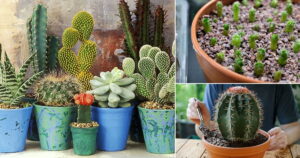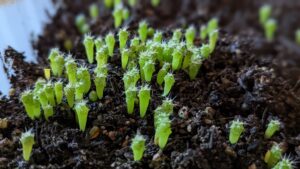Have you ever gazed at your Leggy Bunny Cactus and wondered why it looks more like a stretched-out shadow of its former self? If so, you’re not alone. Many cactus enthusiasts face the challenge of their Bunny Cactus—scientifically known as *Coryphantha*—becoming elongate or “leggy.” Stretching is often a sign of insufficient light or improper care, which can diminish the aesthetic charm of this uniquely playful plant. However, with the right insights, you can restore its delightful plumpness and promote healthy growth. Let’s delve into the ways to grow a Leggy Bunny Cactus and tackle the dilemma of leginess head-on.
Understanding the Leggy Bunny Cactus
The Leggy Bunny Cactus is not just another plant species; its fascinating anatomy boasts adorable bunny ear-like protrusions and a distinctively rounded body, making it a favorite for both novice and seasoned gardeners. However, the allure can wane when the cactus starts to stretch awkwardly. Understanding the factors that contribute to this condition is paramount for rejuvenating your plant.
Legginess generally occurs due to etiolation, a growth pattern in which plants reach for light sources, causing them to become elongated with sparse foliage. In the context of cacti, this typically manifests when they are not receiving sufficient sunlight—an essential element for photosynthesis. The result? A cacti that looks straggly rather than the compact and charming sphere it is meant to be.
Besides light deprivation, other factors can contribute to the elongation of your Leggy Bunny Cactus. These include overwatering, insufficient nutrients, or inadequate airflow. Now that we’ve identified the causes, let’s explore effective methods to correct this issue and encourage thriving, healthy growth.
Optimizing Light Exposure
Light is undeniably the lifeblood of all flora, especially cacti. To maintain your Leggy Bunny Cactus in its prime form, you need to ensure it receives ample sunlight. Ideally, these plants flourish in bright, indirect light for at least six hours a day. Inadequate sunlight can prompt the cactus to stretch towards the light source, leading to that regrettable leggy appearance.
Consider positioning your cactus near a south-facing window to optimize its light intake. If natural light is limited, supplementing with grow lights might be the solution. LED grow lights provide the necessary spectrum without causing overheating, which could negatively affect your plant. Adjust the height of the lights so they are no further than a few feet above the cactus, ensuring the light penetrates deeply enough to spark healthy, bushy growth.
Watering Wisely
Another critical factor that influences the growth of your Leggy Bunny Cactus is the watering regime. It’s a common misconception that cacti thrive on frequent watering. In reality, overwatering can exacerbate stagnation and encourage leggy growth. Cacti are adapted to arid environments and require their soil to dry out completely between watering sessions.
To water effectively, check the soil moisture. If the first inch of the soil feels dry to the touch, it’s time to water. Use room-temperature water and ensure that the pot has adequate drainage holes to prevent waterlogging. Rainwater or distilled water can be an excellent choice, as they are free from chemicals that may affect soil health.
During the growing season, typically spring and summer, you can water more frequently; conversely, reduce waterings during the dormant period in fall and winter. This routine prevents your Leggy Bunny Cactus from becoming stressed, minimizing the chances of elongation.
Soil Considerations and Nutrient Needs
While light and water are crucial, the quality of the soil used is equally significant when it comes to growing a robust Leggy Bunny Cactus. Opt for a well-draining cactus mix that contains components like perlite, coarse sand, and potting soil. This mixture will promote healthy root development while preventing the risk of oversaturation.
Nutrients play a vital role in bolstering your cactus’s potential for growth. A balanced, diluted cactus fertilizer applied during the growing seasons can supply essential nutrients and stimulate natural growth patterns. Be cautious not to over-fertilize, as this can lead to further leggy growth due to rapid, uneven expansion.
Moreover, consider repotting your cactus every couple of years to refresh its soil and allow room for growth. Choose a pot that is slightly larger than the current one to encourage expansion in the root zone without overwhelming the plant.
Encouraging Compact Growth
For those already grappling with a leggy Bunny Cactus, pinching back the top growth can stimulate branching, which helps to re-establish a more compact appearance. After pruning, ensure the health of the plant remains paramount. Allow the cut to heal before watering again.
The key to thriving cactus care lies in patience and observation. Monitor the changes in your plant’s growth and make necessary adjustments as it thrives. Don’t be discouraged by a past that might have seen your Bunny Cactus stretching toward the sun; instead, revel in the knowledge that restoration is within your grasp.
In conclusion, growing a Leggy Bunny Cactus might present its challenges, but with a proactive approach towards light, water, and nutrition, you can foster a resilient and aesthetically pleasing cactus. Embrace the joy of cultivating this charming plant, and soon, you’ll be rewarded with a lush and lively display—one that celebrates the whimsical, delightful character of your Leggy Bunny Cactus.





Leave a Comment